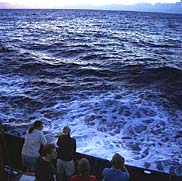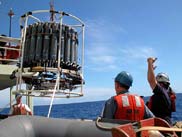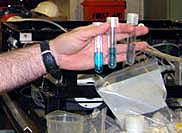|
|
|
|
|
|
|
|
|
| Sun |
Mon |
Tue |
Wed |
Thu |
Fri |
Sat |
|
|
 |
|
Q. I want to be a chemical engineer when I get older. Does this kind of mission and other missions like it have chemical engineering involved? (From Danielle S., East Central Middle, Hurley, MS)
A. While there are no chemical engineers on this cruise, there are chemists and there are engineers working on the science! Oceanography in general, is a very multidisciplinary science and people usually come into oceanography after first getting training in some more specific field. There's no reason why a person trained in chemical engineering couldn't work on a program like this- it would just be a matter of developing a specific project that makes use of their training. I often think of a chemical engineer as one who takes known chemical reactions and scales them up to industrial sized processes. That's not something we do out here. However, there is a lot of interest in biochemical processes and enzymatic chemistry that takes place at hydrothermal vents and these are the kinds of science that I would expect a (bio)chemical engineer might make use of. As you study your chemical engineering, you should try and take some oceanography courses and visit some oceanographic institutions- you might very likely find someone who knows of a project that could use someone with your training.
|
 |
|
 |
|
|
|
|
|
 |
This cruise presents some personal firsts for me. I have been doing chemical analyses of hydrothermal plumes and vent waters since 1984, and this is my first time in the Atlantic Ocean. If I could invite you to go up on the bow of this ship and look at the ocean surrounding us, it doesn’t look any different than the middle of the Pacific Ocean where I usually go to sea. But from a chemist's point of view, it is very different. To understand the chemistry of the hydrothermal fluids, we must first know something about the seawater chemistry nearby (called "background concentrations") for comparison. Here is where the Atlantic and Pacific differ. Below 500 meters, when you look at the same depth, there is 8 times more silica in the North Pacific than there is here. This is due to deep water circulation.
 |
|
A view of the sea from the starboard (right side) of the R/V Atlantis.
|
Deep waters of the Atlantic were more recently surface waters than those of the North Pacific. But how does the surface seawater become deep seawater? The answer is density. Cold seawater is denser than warm seawater and saltier seawater is denser than less salty seawater. Drier, warmer climates cause more evaporation from the ocean and less rain, and the surface ocean becomes saltier. If currents transport this saltier water to a cold climate, the surface seawater becomes denser and sinks under less dense seawater. This does happen off Greenland and near Antarctica. The Mediterranean Sea also contributes as evaporation takes place there, and outflow from the Mediterranean sinks to about 1000 m in the Atlantic. The link between silica and density is in the surface seawater. Surface seawater is silica poor as diatoms (a type of phytoplankton with a silica “shell”) remove dissolved silica from seawater.
When diatoms are eaten by zooplankton, their “shells” are excreted and fall to deep water where silica is dissolved.
 |
|
CTDs are an instrument package that provide some of the water for scientists to use during analyses.
|
The general flow of deep seawater is from the North Atlantic south and eventually to the Pacific. By the time deep seawater reaches the North Pacific, there has been much more “rain” of diatoms and other organic matter over time and a higher dissolved silica concentration in the North Pacific. My job here is to analyze hydrothermal fluid from Lost City for silica, ammonia and dissolved sulfide. To determine ammonia, sulfide and silica, I react water samples with other chemicals to make colors. Then, using an instrument called a spectrophotometer, I measure the amount of light absorbed by the colored compound I have made.
The amount of light absorbed is proportional to the amount of silica, ammonia or sulfide that was in the water sample. Another first for me and for most of us aboard is working at Lost City. The chemistry of the vents is much different than anything we have seen at black smokers. These hydrothermal fluids have some sulfide like black smokers, but are basic in pH rather than acidic and are low in silica, as much as 1000 times less than a black smoker vent. This presents some problems for me when I analyze Lost City vent fluids for silica.
 |
|
Kevin holds samples that have been reacted with chemicals. These produce interesting colors.
|
Sulfide interferes with both ammonia and silica analyses. If I don’t get rid of sulfide in the sample, I get a result that is in error. Silica is very low here and sulfide is present in concentrations high enough to cause problems in both silica and ammonia analyses. So I have to add acid to the sample and bubble nitrogen gas through the sample. The acid turns dissolved sulfide into hydrogen sulfide gas and it is bubbled out of solution by nitrogen. Hydrogen sulfide is the rotten egg gas that has been mentioned a lot in this website. Our nose is very sensitive to very low concentrations of hydrogen sulfide. So the by-product of my work here is pretty colors, bad smells, and new information on hydrothermal venting in the ocean.




